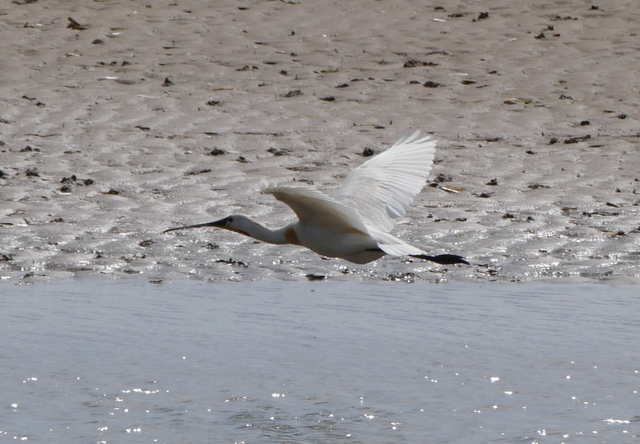Another Private Tour today, based in North Norfolk. What glorious weather – mostly clear and sunny, light winds, and the temperature over 20C. That’s more like it!
Turtle Dove was a particular target, so we headed towards the Heath, which is a good area still for this rapidly disappearing species. On our way, we had a Barn Owl hunting beside the road, which just flew up for a second before disappearing behind a high hedge. Presumably it had young to feed. It seemed a perfect day to be up on the Heath. The Willow Warblers were singing from the birches and lots of Linnets were perched up on the tops of the gorse bushes calling. Everywhere we went, we seemed to bump into a Yellowhammer singing, which is always a great pleasure.
 Yellowhammer – singing everywhere on the Heath this morning
Yellowhammer – singing everywhere on the Heath this morning
As we walked round, we could hear a Garden Warbler singing. However, as we headed towards it, we heard the distinctive purring of a Turtle Dove. The Turtle Doves have some favourite trees they like to purr from and the noise seemed to be coming from that direction. We made our way there and it didn’t take long to find a Turtle Dove perched in the middle of a birch tree. We got it in the scope and had a good look at it before it flew off through the trees.
That was a good start, so we thought we would look for the Dartford Warblers as well. However, despite the seemingly perfect conditions, they were not being helpful today. We waited a little while, but they were not calling, so we decided our time was better spent elsewhere. As we walked back, a Common Lizard ran across the path and a couple of Cinnabar Moths flew up as we passed.
We headed down to Cley next. Driving along the coast road, we could see a Spoonbill out on one of the pools on the grazing marsh at Salthouse. It was doing what Spoonbills like to do most – sleeping! The East Bank at Cley has been the most productive area in recent weeks, so we stopped at Walsey Hills and walked out along the bank. There has been a Spoonbill here regularly in recent days, but presumably it was asleep at Salthouse today! We did see several Little Egrets, including one with particularly long nape plumes, a smart breeding adult.
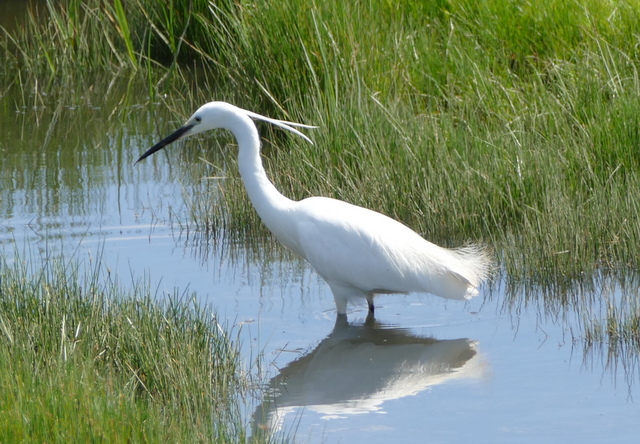 Little Egret – a very well-plumed individual
Little Egret – a very well-plumed individual
There were lots of Lapwing and Redshanks, all fighting for territory, along the Serpentine, and good numbers of Avocet, but no other waders of note out on Pope’s Pool today. We could see the pair of Marsh Harriers distantly over Pope’s Marsh, but a darker male flew in from the east over them, prompting a little territorial circling. This was the Cley Marsh male, and he flew over our heads and landed out in the reedbed in the top of a bush. We had a good look at him in the scope.
We could hear plenty of Reed Warblers singing from the reedbed and we saw the odd one perched up briefly in the reeds. A Sedge Warbler was even more accommodating and sat in the top of a small sallow on the edge of the reedbed where we could get a close look at it. The Bearded Tits have also been very obliging here recently, but they were not today. On our way out, we couldn’t hear or see one!
 Sedge Warbler – singing from the top of a bush as usual
Sedge Warbler – singing from the top of a bush as usual
We walked up to Arnold’s Marsh, which was also a bit quiet today. We did see a couple of Little Terns on one of the islands and a single Ringed Plover, as well as a small flock of Black-tailed Godwits. However, as we turned to walk back we finally heard the pinging of Bearded Tits. A male skimmed over the tops and dropped down into the depths of the reeds in front of us. After a couple of minutes he flew up again and disappeared again only a few metres further over, with a second bird calling nearby. Then they went quiet again. Still, at least it was a start.
We were not planning to walk out onto the reserve itself today, as it has been a little quiet in recent days, but we popped into the Visitor Centre to double check what had been seen. There was nothing on the sightings board, but as we turned to leave a quick scan revealed a couple of Little Gulls and a Greenshank in amongst a large flock of Black-tailed Godwit, so we changed out minds. As we walked along the path beside the road, a Grey Heron flew up ahead of us and perched on the rail of the footbridge. Nearby, a nice obliging Moorhen stood on the edge of the ditch preening.
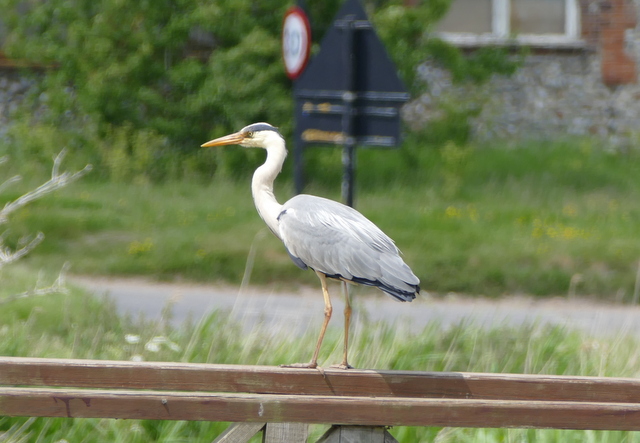 Grey Heron – perched up on the bridge today
Grey Heron – perched up on the bridge today
 Moorhen – so obliging, it deserved a photo
Moorhen – so obliging, it deserved a photo
As we approached Teal Hide, something spooked the Black-tailed Godwits and they all took off, frightening everything else as well. We half expected to see nothing left on Pat’s Pool when we got in the hide, but thankfully they all landed again. The Greenshank had now separated itself from the Godwits, but was mostly asleep. It woke up briefly when a Black-headed Gull tried to land on it, and we had a good look of it in the same scope view as a Redshank for comparison. There were at least 110 Icelandic Black-tailed Godwits on the scrape, most in winter plumage or with a few summer feathers, but a nice summer adult landed right in front of the hide. Apart from all the nesting Avocets, the only other wader of note here today was a single Little Ringed Plover.
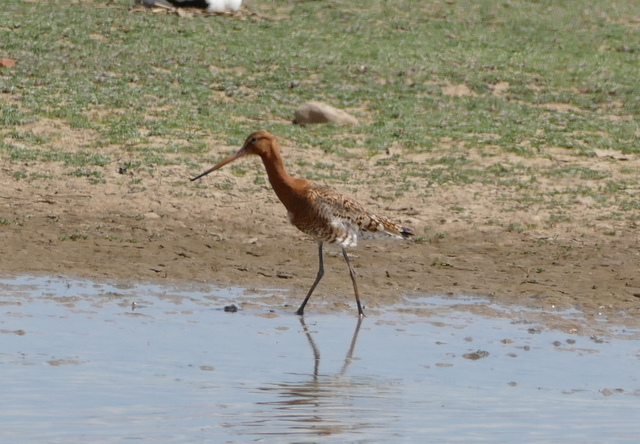 Icelandic Black-tailed Godwit – in summer plumage
Icelandic Black-tailed Godwit – in summer plumage
The Little Gulls were a little closer from the hide than they had been from the Visitor Centre. They were both 1st summer birds, neither with much black on the head. They were picking around on the mud around the edge of the islands today, rather than flying round catching insects. There have been a lot of 1st summer Little Gulls lingering along the coast in recent weeks, but it is always good to catch up with them.
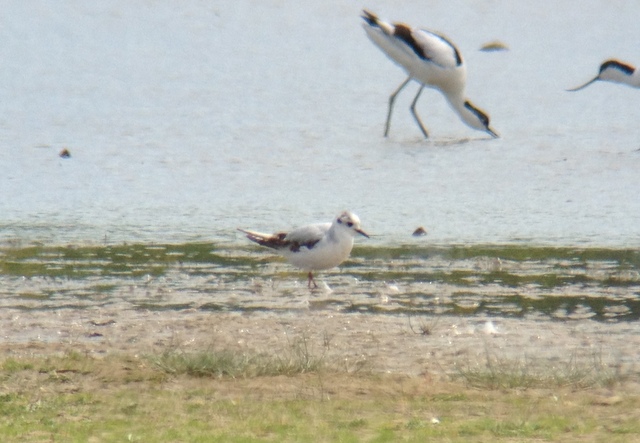 Little Gull – 1 of 2 1st summer birds at Cley again today
Little Gull – 1 of 2 1st summer birds at Cley again today
While we were looking out from the hide, we heard the distinctive pinging of Bearded Tits again. This time, they flew in and landed in a narrow line of reeds in front of the hide. They dropped in out of view at first but quickly ran out of cover to hide in and worked their way up the dead reed stems. The Bearded Tits perched up in full view for a couple of seconds – two juveniles – before flying off behind the hide. Great stuff.
We had a quick look out from Dauke’s Hide, which was very quiet, and were initially similarly disappointed by the view from Avocet Hide. However, we heard the rush of wings first – something was flying really fast. Then a Hobby shot in from over the roof of the hide and powered towards an unsuspecting House Martin. At the last minute, the House Martin saw it coming and took emergency evasive action. The Hobby missed and turned for more, but the House Martin was now wise to it and flew off, with the Hobby still in pursuit. Even better stuff. Then it was time for lunch back at the Visitor Centre.
In the afternoon, we headed back west to the other side of Holkham, to walk out towards the dunes at Burnham Overy. Warbler activity was a bit more subdued this afternoon than recent mornings. We heard a Lesser Whitethroat singing briefly and saw one flick across the path in front of us. The Common Whitethroats were not singing as much as they have been and even the normally very vocal Sedge Warblers were mostly quiet. It was the middle of the day, and hot by now, so perhaps not surprising that activity has dropped.
While we were still amongst the bushes on the way out, we saw a Spoonbill fly west across the path over by the seawall, but it was too quick to get everyone onto it. There are often Spoonbills on the reedbed pool but when we got up onto the seawall we couldn’t see any today – only two more Little Egrets. However, we did hear a Bittern booming briefly. We could also see a Spoonbill very distantly, in the harbour channel towards Scolt Head, possibly the bird which had just flown over in that direction.
We carried on out towards the dunes. A Cuckoo flew in across the saltmarsh from Gun Hill and disappeared inland, chased by a Meadow Pipit. Otherwise, there was not much new to see on the walk out today – lots of Linnets and Reed Buntings.
From out to Gun Hill, we had figured we might be able to find the Spoonbill in the channel, but when we got all the way out there we couldn’t find it. There were lots of Ringed Plovers on the beach and a little group of Turnstone on a muddy island, including one stunning summer plumage individual with white head patches and rufous back.
There didn’t seem to be many terns initially, but when a Carrion Crow flew over from the direction of Scolt Head, a small cloud of Little Terns suddenly erupted from the beach, with a single Common Tern in amongst them. After that, the Little Terns started feeding in the channel alongside us and we had some stunning views of them. A single Sandwich Tern came in along the deeper part of the harbour channel as well – one good tern deserves another two at least!
 Little Tern – feeding in the harbour channel at Gun Hill
Little Tern – feeding in the harbour channel at Gun Hill
We had all but given up hope of finding the Spoonbill when it suddenly flew in from round the corner and landed on the edge of the channel to feed. We got a good look at it in the scope. It wasn’t too distant from here, and we could see its mustard yellow breast patch, nuchal crest and yellow bill-tip. We thought that was good, but then it took off and flew towards us, landing half as close again. Great. Then it took off a third time and landed in the channel right in front of us. Stunning!
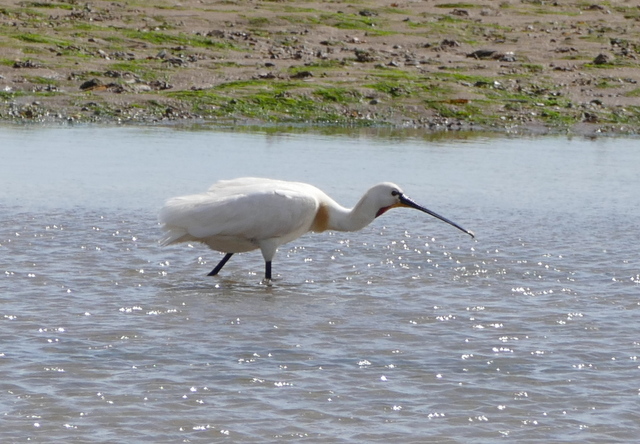 Spoonbill – …and landing in the channel right in front of us
Spoonbill – …and landing in the channel right in front of us
We watched the Spoonbill feeding in the shallow water, sweeping its bill from side to side. It flicked its head up a couple of times as it caught something. Then it took off again and flew further up the channel. That seemed like a great way to end, so we set off for the long walk back to the car. On our way, what was presumably ‘our’ Spoonbill flew back over the seawall and headed in the direction of the breeding colony – presumably it has some young ‘teaspoon-bills’ to feed somewhere over there!
